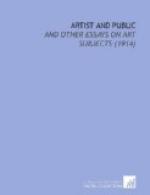Others of our artists are going still further back in the history of art for a part of their inspiration. Mr. Brush has always been a linealist and a student of form, but his earlier canvases, admirable as they were, were those of a docile pupil of Gerome applying the thoroughness of Gerome’s method to a new range of subjects and painting the American Indian as Gerome had painted the modern Egyptian. In recent years each new picture of his has shown more clearly the influence of the early Italians—each has been more nearly a symphony of pure line.
Even in purely technical matters our painters have been experimenting backward, trying to recover lost technical beauties. The last pictures of Louis Loeb were underpainted throughout in monochrome, the final colors being applied in glazes and rubbings, and to-day a number of others, landscape and figure painters, are attempting to restore and master this, the pure Venetian method, while still others, among them Emil Carlsen, are reviving the use of tempera.
But it is in our mural painting even more than elsewhere that the conservative or reactionary tendency of American painting is most clearly marked. John La Farge was always himself, but when the general movement in mural painting began in this country with the Chicago World’s Fair and the subsequent decoration of the Library of Congress, the rest of us were much under the influence of Puvis de Chavannes. Even then the design was not his, but was founded on earlier examples of decorative composition, but his pale tones were everywhere. Little by little the study of the past has taught us better. American mural painting has grown steadily more monumental in design, and at the same time it has grown richer and fuller in color. To-day, while it is not less but more personal and original than it was, it has more kinship with the noble achievements of Raphael and Veronese than has any other modern work extant.
And this brings us to the second characteristic of the American school of painting: it is rapidly becoming a school of color. We have still plenty of painters who work in the blackish or chalky or muddy and opaque tones of modern art, but I think we have more men who produce rich and powerful color and more men who produce subtle and delicate color than any other modern school. The experiments in reviving old technical methods have been undertaken for the sake of purity and luminosity of color and have largely succeeded. The pictures of Mr. Tarbell are far more colored than those of the European painter whose work is, in some ways, most analogous to his, M. Joseph Bail. Mr. Hassam’s color is always sparkling and brilliant, Mr. Dewing’s delicate and charming, Mr. Weir’s subtle and harmonious and sometimes very full. Even Mr. Brush’s linear arrangements are clothed in sombre but often richly harmonious tones, and the decorative use of powerful color is the main reliance of such painters as Hugo Ballin. But the note of color runs through the school and one hardly needs to name individual men. Whether our landscapists glaze and scumble with the tonalists, or use some modification of the impressionist hatching, it is for the sake of color; and even our most forthright and dashing wielders of the big brush often achieve a surprising power of resonant coloring.




